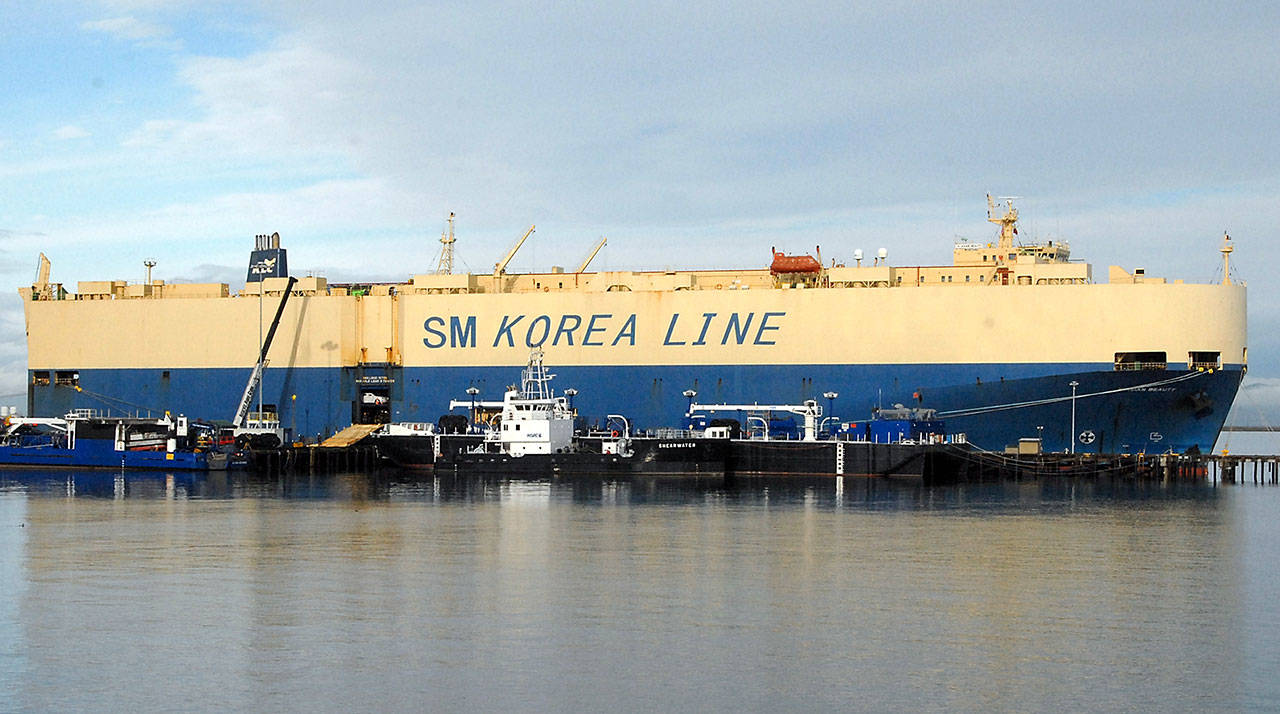EARLY IN THE week, K. Asian Beauty, a 604-foot car carrier with a 98-foot beam, anchored in the west end of the harbor. I understand the Panamanian-flagged vessel had a mechanical issue and the crew was looking for a safe harbor to make repairs.
Friday morning, the ship moored to the Port of Port Angeles’ terminal one. A crane was required to hoist a piece of needed equipment aboard the ship. Once the task was completed the vessel moved back out to anchorage to wrap up the repairs.
Cable Innovator, the 477-foot cable layer that had been moored to terminal one for the last month, got underway at 7 a.m. Friday morning for her customary berth in Victoria from where she responds to emergency requests to repair fiber optic cables that stretch from the west coast to Asia along the ocean floor for various telecom companies.
I expect to see the ship back in Port Angeles in the near future.
Today, Polar Resolution will moor to terminal one for three days while Vigor Industrial performs a myriad of maintenance tasks on the crude oil tanker that is an integral part of the Conoco Phillips Fleet.
Thursday, the fully loaded log barge Z Big One came into the harbor, made her way to the west end of the harbor and then reversed course and hung out more in the middle of the harbor.
She, too, was only looking to get in out of the weather.
Wednesday, Tesoro petroleum provided bunkers to Ocean Venture, a 656-foot bulk cargo ship that is flagged in Hong Kong.
Thursday, Tesoro refueled Medi Brisbane, which is also a 656-foot bulk cargo ship; she is flagged in Panama.
Thursday evening, HMS 2000 Tesoros’ refueling barge was taken to a ship yard in Vancouver, B.C. where she will spend time in dry dock undergoing a routine 5-year inspection.
I understand she may also get a little paint splashed on her. Maintenance work will be done on the crane and a new generator will be installed.
The barge, which has a load capacity of 735,00 gallons, should be back in service Feb. 4.
History of the bosun
I have often been asked, “What is a bosun and what do they do?”
The term “bosun” is a colloquialism derived from “boatswain,” which is the formal spelling of the word.
Both words stem from a much older English word, batswegen.
The batswagen was a boy or follower of the boat and generally considered to be more of a servant than a crew member.
The function of the job evolved with the word, which turned into boatswain in the late 1400s.
Gradually, the pronunciation of the word changed, and the spelling began to reflect that: Sailors use the spelling of “bosun” to refer to boatswains.
In fact, if you look up boatswain up in the dictionary, most of them will have the pronunciation as bosun.
Today, the bosun is an integral part of a ship’s crew — directing, organizing and coordinating the work and duties of the deck force.
Bosun’s mates and the deck crew of a naval ship are responsible for all topside spaces from the waterline to the bridge with the exception of weapon systems, communication systems, radar and the signal bridge.
They also operate and maintain the boats aboard ship, including running liberty boats when a ship is at anchor and transporting the captain of the ship aboard his gig.
At one time, bosun’s mates relied on a bosun’s pipe to relay orders to the deck crew.
The sound could be clearly heard over other noises on a busy ship, and in some navies, whistling by crew was forbidden to avoid confusion.
In the modern navies, the bosun’s pipe is used in formal ceremonies and piping senior officers on and off of ships, raising and lowering of colors and announcing reveille and taps.
Historically, the bosun’s pipe was also considered to be a badge of rank because ordinary seamen were not permitted to wear or use one.
For all you history buffs out there, bosun’s mate is the oldest rate in the U.S. Navy.
According to the USN history site, the rate was in use in 1775 and formally established in 1797.
Not all ratings of this early era have retained their identity because the majority of the ratings today have evolved from later technical developments.
While jobs and duties have changed, the rating of bosun’s mate has remained the same since the American Revolution.
_________
David G. Sellars is a Port Angeles resident and former Navy boatswain’s mate who enjoys boats andstrolling the area’s waterfronts and boat yards.
Items and questions involving boating, marina and industrial activities and the North Olympic Peninsulawaterfronts are always welcome. News announcements about boating groups, including yacht clubs andsquadrons, are welcome as well.
Email dgsellars@hotmail.com or phone him at 360-808-3202.

